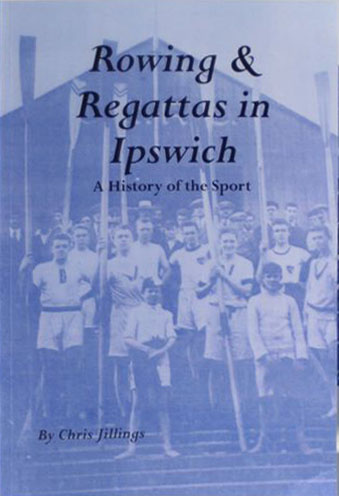- Screen Colours:
- Normal
- Black & Yellow
 A new publication: Rowing & Regattas in Ipswich by Chris Jillings. 2020.
A new publication: Rowing & Regattas in Ipswich by Chris Jillings. 2020.
This diligent book rises from a mass of newspaper archives, the Record Office, libraries and photographic collections to document the history of rowing and regattas in the town. Many of the photographs are from the IMT archive and the book is an excellent companion to this year's IMT calendar.
Chris Jillings took an interest in rowing the Orwell in the 1980s and set up a new Ipswich Rowing Club in 2013 that has been so successful that two women training from the New Cut were awarded the Club Crew of the Year (UK) by British Rowing.
The historical context is explained well. Competition to drop off a pilot in all-weathers fostered the design of fast gigs that were raced in annual regattas held around the coast for substantial prizes. Inland competitive rowing started in East Anglia in 1813; an Ipswich Galley Club is mentioned by 1835. Two years later a large Ipswich Town Regatta coincided with Victoria's Coronation. Subsequently boats from the Ipswich Aquatic Club, Orwell, Nautilus, Petrel and Naiad rowing clubs, joined by teams from several industrial works and pubs, competed with visiting crews from around East Anglia. Competitive women's teams were seen throughout the Victorian era. By 1862 a crowd of 25,000 jostled on the Wet Dock to witness rowing, sailing and swimming races. Even bigger crowds were seen periodically until regattas started to wind down in 1913.
There were plenty of sinkings and fallings-in, though fortunately few fatalities. The crowd were treated to spray from the earliest torpedoes, exploded for their amusement in 1871. Most races were rowed between the Wherstead Beacon and the committee boat moored outside the lock gates, though timed-start races up the Gipping were also held.
In 1905 the Woolwich Bell cut the Hog Highland bend too fine at full speed to demolish a skiff. The five crew were rescued, one embarrassed to be without his shorts, by the packed paddle steamer.
A fire in 1948 destroyed the two splendid rowing clubs that had been built at the edge of the salt water bathing place in 1903. Since then, the potential for the river in the town to be an aquatic park has faded from public consciousness. We should lament the loss of the splendid tree lined boulevard on the Wet Dock to a desolate, locked lorry park; the loss of beach access at Hog Highland; replacement of the swimming pool and riverside gardens of Wherstead Road by the West Bank Quay; the banning of public access to the lock gates, Umbrella site and Ship Launch Road; the concreting of much of the Gipping river bank and the extensive silting of the New Cut.
A useful addition to the shelves of those interested in maritime Ipswich, this book is a timely reminder of what might be achieved. Most of the hive of social activity and sport were carried out in the past in a river thick with sewage and industrial waste. Now, the Orwell is cleaner than at any time in the last two hundred years, yet not used by the majority of the town.
The Island site and dock will develop further. Whether this is dominated by gated towers of second homes, or whether there will be greater access for the communities of the town for sport and leisure, will depend on an informed public who is aware of what has gone before. Chris Jillings has led the way in restarting competitive rowing in Ipswich and I recommend his book.
Price £20. Contact Chris at: intertech@btinternet.com
John Warren
[This article courtesy of The Ipswich Maritime Trust.]